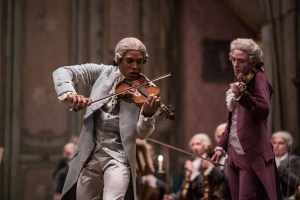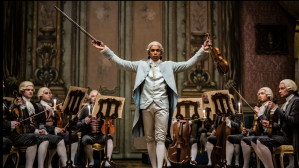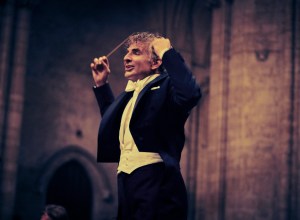When creating a biographical drama of a historic figure, there’s a delicate balance between striving for historical accuracy and focusing on crafting a compelling, human story. This awards season has seen its fair share of biopics, testing their costume designers in different ways.
Oppenheimer uses timeless wardrobe pieces to sketch its self-consciously stylish hero. With few recorded images to draw on, Chevalier takes some informed liberties to tell the story of 18th-century musician Joseph Bologne. Maestro, meanwhile, draws on style trends and snapshots from a storied life to dress famed composer Leonard Bernstein.
Matt Damon as Leslie Groves Jr. and Cillian Murphy as J. Robert Oppenheimer
Universal Pictures/Everett Collection
Oppenheimer
For Christopher Nolan’s Oppenheimer, costume designer Ellen Mirojnick says the focus was not on creating a biopic, but a portrait of a man who changed the world. “Chris was very clear,” she says. “We are not making a documentary. We are not looking for exactness nor preciousness, or anything that is stylized and put there just because it’s the correct period.” This meant finding “timeless” pieces for the costumes, rather than clothing that just fit the time period.
With that in mind, Mirojnick instead focused on a few iconic things that became the foundation of her designs, most important of which is his silhouette. “What we found in the research immediately was his silhouette stayed the same from the beginning to the end of his life,” she says. “It was very elegant, very fine tailored and there was a simplicity to the style.” The silhouette became the main focus of her designs, as it accounted for how the jacket hangs on Oppenheimer’s frame, how the fabric bunches around his legs and, of course, there’s the iconic hat.

From left: Benny Safdie as Edward Teller with Murphy.
Melinda Sue Gordon/Universal Pictures/Everett Collection
Mirojnick worked closely with Cillian Murphy in the design process of the Los Alamos silhouette, as each piece of clothing had to be sculpted to his form. “Cillian was the absolute perfect embodiment of Oppenheimer,” she says. “He was frail and he knew how to exact the stance, but he didn’t have the walk yet. That was going to be dependent on how the clothes draped, how they felt around him and the trousers being voluminous, which allowed him a stance with a hand on a hip that looked odd to us, but was ever so much Oppenheimer.”
The real-life Oppenheimer cut a distinctive, stylish figure, which Mirojnick thinks was no accident—if his brain was chaotic, Oppenheimer carefully crafted his look and controlled how he wanted to present himself to the world. “First and foremost,” she says, “the character of Oppenheimer is such a conflicted, complicated character. He was obsessed with physics, with the unknown… it filled him. That being said, he was very conflicted and contradictory because there was great insecurity, frailty and unknowingness about his physical being.”
“There’s great responsibility in working with a historical figure,” she says. “I think it is a responsibility not only in telling the story and representing the person, but bringing a truth to that human being that will hopefully help the audience relate to that character.”

Kelvin Harrison Jr. as Joseph Bologne, Chevalier de Saint Georges, in Chavalier.
Larry Horricks/Courtesy of Searchlight Pictures
Chevalier
Designing clothing for Chevalier presented a challenge and an opportunity for costume designer Oliver Garcia. Although Joseph Bologne, known as Chevalier de Saint Georges, was a celebrated composer in his life, much of his work was destroyed by Napoleon after the French Revolution. “You go diving into history books and try to find paintings, illustrations, whatever artwork there is that represents the characters in the script,” Garcia says. “There’s not many paintings that exist for a lot of the characters in the film. Most of them have been forgotten to history.” For Chevalier himself, Garcia says there are only two or three paintings of him that still exist. “There was a lot that we had to imagine and recreate.”

Kelvin Harrison Jr in ‘Chevalier’
Larry D. Horricks/Searchlight Pictures
This presented an opportunity for Garcia to connect the costumes with how the story was being told. The first connection Garcia made was choosing the color blue for his outfits. “The color was chosen because it had a connection to Marie Antoinette. It is historically recorded that she was very fond of the color blue, so to us it made a storytelling sense to depict him wearing that color.” After being given the title of Chevalier from the queen, he became close with her and used that connection to further his career in a society that was not very accepting of him. “We wanted to say he was a very smart person living in a very prejudiced society,” he says. “He understood the power of dressing and how you can influence people around you by the way that you dress.”
Later in the movie, when Chevalier has a falling out with Marie Antoinette, his clothing changes to create a distinction from the aristocratic circles he once traveled. “He’s been cast out from this society, and he starts finding himself and connecting with the African community that his mother introduces him to,” says Garcia. The iconic light blue jacket is gone, as he begins to wear less aristocratic clothing and darker colors. This part of the film takes place nine months after he’s been cast out, so the changes may seem subtle but are significant as he’s finally accepting his African roots more than the French culture that was forced upon him. “He’s been exposed to a whole different type of people that wear different types of clothing, so we wanted to say that he moved on from his past.”

Bradley Cooper as Leonard Bernstein in Maestro.
Jason McDonald/Netflix
Maestro
The story of Maestro takes place over more than 40 years of Leonard Bernstein’s life, so costume designer Mark Bridges needed to be thorough in his research. “I have a big print library, old-fashioned books with photo essays in them, and a lot of vintage magazines as well,” he says. “Because we just had Lenny’s hundredth anniversary birthday in 2018, there were other publications of photos of him, compilations and things.”
Although there were many documented images of Bernstein, Bridges says he was never pressured to create exact replicas of outfits. “You pick and choose what you research, and you make things up with calculated research. There’s a beautiful photograph of Lenny conducting with a beard, and he has the blue and white striped shirt on with a kerchief.” Bernstein only had a beard for about six months in 1976, so Bridges decided that replicating this outfit would give an accurate representation of that time. “Sometimes you make things up, and sometimes you pick from reality because it’s so good.”

Cooper with Carey Mulligan as Felicia Montealegre
Jason McDonald/Netflix
Most of Bridges’ designs focused more on style trends during that period of Bernstein’s life. “I always try to be very specific to time and place,” he says. “Carnegie Hall’s a little more wintery, and Tanglewood takes place in the summertime of 1989, so it’s a summer palette.” With this basis, Bridges says it’s important to “touch the real clothes” of the time. “A lot of it has to do with putting my hands on real clothes and being inspired by actual garments. What are the shapes and the fabric details, or the lapel widths from 1943, or the casualness of 1989 where everything was striped and lovely pastels… it’s fun to revisit all of those periods.”
Without creating replicas of famous outfits, Bridges says the most important part of his job was to honor a “very well-documented” life. “We’re doing a compilation of different events, so there’s no one thing to look at, but you get a sense of who they were and you’re able to make decisions based on that.” Creating motivations for each costuming decision was essential, like having a double-breasted suit for Bernstein’s debut, because he would most likely only have one good suit for an emergency, or choosing a watch that looks like a graduation present because he couldn’t afford anything fancy at the time. “Even at the end of Lenny’s life, without Felicia guiding him there, he made a few missteps, like it’s a little too young and a little too flashy, but that’s part of telling the story of a life.”

